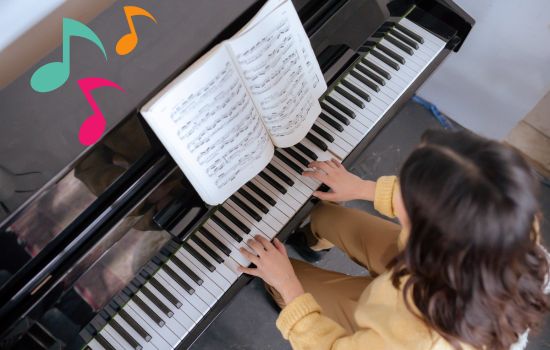In a world where digital entertainment is often limited to passive content consumption, resuming the practice of an ancient art like piano playing represents an act of personal empowerment.
You no longer need to invest thousands of dollars in in-person classes or rely on distant conservatories: today, with free tools and your own home, you can hone your skills as a pianist.
Below is a seven-step plan, accompanied by reflections on the importance of music and a detailed guide to the application. Simply Piano, so that your musical journey surpasses a thousand words and, above all, translates into tangible results.
1. Reasons to Choose the Piano as Your Instrument
Before describing the learning path, it is useful to understand why the piano stands out among instruments:
- Melodic and Harmonic Versatility. Unlike pure melodic instruments (flute, violin), the piano allows you to play melody and accompaniment simultaneously.
- Base for Other Instruments. Knowing chords and scales on the piano makes it easier to learn guitar, bass, or digital synths later on.
- Initial Technical Accessibility. Although it takes years to master, the first notes are produced relatively easily: just press the keys.
- Repertory Wealth. From Baroque to jazz, from Chopin to Coldplay: the catalogue of piano pieces is immense.
See also
- Advanced Strategies to Get the Most Out of Your Mobile Battery
- How the Love Calculator Reveals Your Love Compatibility
- The Secret Language of Numbers: Numerology Reveals Now
- Shine Every Day: Your Free Daily Horoscope
- Feel the Dust of the West: Immerse yourself in the World of the Western!
These factors make the piano a strategic choice for both hobbyists and aspiring professional musicians.
2. Holistic Benefits of Playing Piano
Playing the piano is not just an artistic skill, but a practice with positive impacts in multiple dimensions:
| Dimension | Main Benefit | Practical Result |
|---|---|---|
| Cognitive | Improving working memory | Greater ability to retain complex information |
| Emotional | Regulation of stress and anxiety | Feeling of calm after each practice session |
| Physics | Hand-eye coordination and fine motor skills | Precision in digital and everyday movements |
| Social | Connection with other musicians | Opportunities for collaborations and presentations |
| Professional | Skill valued in multiple industries | Possibility of teaching, accompaniment and composition |
These interrelated benefits justify the time and effort invested in the learning process, as they are reflected in real improvements in your daily life.
3. Design your Study Plan in 7 Steps
Below is a clear roadmap to structure your progress to learn to play the piano from scratch:
- Definition of SMART Objectives.
- Specific: “Learn the C major scale in two weeks.”
- Measurable: “Practice 20 minutes daily, five days a week.”
- Achievable: Adjusted to your time availability.
- Relevant: Related to pieces that motivate you.
- Temporary: With a deadline to evaluate achievements.
- Team Selection
- MIDI Keyboard or Digital Piano: Ideal for connecting with apps.
- Headphones or Studio Monitors: For clear audio without disturbing neighbors.
- Firm Support and Adjustable Chair: Correct posture prevents injuries.
- Creating an Optimal Environment
- Focused lighting on the scores.
- Soft surfaces (carpet) to dampen sound.
- Order and cleanliness to minimize distractions.
- Use of Free Resources
- Educational YouTube: Channels like “Piano Lesson with Warren” or “HDpiano”.
- Forums and Communities: Reddit r/piano, Facebook groups, Musicians Discord.
- Notation Software: MuseScore for reading, writing, and playing sheet music.
- Mobile Apps: Mostly Simply Piano, which we will describe in section 5.
- Effective Practice Methodology
- Segmentation Technique: Divide the pieces into bars or groups of eight bars.
- Slow Practice and Progressive Acceleration: Start at 40 bpm and gradually increase.
- Focus Switching: Sessions on hand technique, sheet music reading, and harmony.
- Self-assessment and feedback
- Weekly Recordings: Listen to yourself with a critical ear.
- Recurring Error Log: Keep a practice journal.
- Comparison with Models: Play along with videos of professional performers.
- Consolidation and Presentation
- Videos on Social Networks: Upload performances for feedback.
- Mini Virtual Concerts: Participate in lives with other students.
- Teaching Beginners: Explaining what you have learned reinforces your own understanding.
4. The Role of Discipline and Motivation
Staying consistent is the biggest challenge for any self-taught person. To sustain your momentum:
- Gamification: Set rewards for completing weekly goals (e.g., watching a movie after completing 5 sessions).
- Practice Partner: Find a friend or family member who is also learning piano.
- Variety of Repertoire: It alternates classical and popular pieces and technical exercises.
- Monthly Challenges: Participate in online challenges like “Play25songsin30days.”
The combination of structured discipline and positive reinforcement ensures that you don't quit in the first few weeks.
5. Simply Piano: Your Digital Teacher
Among the many applications that promise to teach piano, Simply Piano It stands out for its comprehensive and free proposal at its initial levels.
Highlighted Features
- Staggered Lessons: From key identification to playing complete pieces.
- Immediate Feedback: Real-time note recognition, corrects rhythm and intonation errors.
- Library of Over 200 Songs: Includes classical, pop, rock and soundtrack genres.
- Offline Mode: You can download lessons to practice offline.
- Progress Reports: Visual statistics for accuracy, speed, and practice time.
How to Use It for Free
- Download and Installation: Available on iOS and Android.
- Basic Registration: Email and password; no credit card required.
- Free Initial Lessons: Complete the first 12 levels for free.
- MIDI or Microphone Connection: Simply place your device near the piano or keyboard.
With these resources, your learning curve will be faster and more reliable than with traditional non-interactive methods.
6. Success Stories and Testimonials
“In three months, I learned to play 'Clair de Lune' thanks to Simply Piano and my own daily routines. Before then, I never imagined being able to read sheet music.”
– Maria Gomez, Sao Paulo
“As a software engineer, I appreciate the app's instant feedback. It helped me hone my technique and understand theory in parallel.”
– Carlos Méndez, Mexico City
These testimonials reflect tangible results: recognizable pieces, confidence, and enjoyment of the process.

7. Conclusion: Your Musical Journey Begins Today
Learning to play the piano for free at home is a perfectly achievable goal if you combine:
- A well-structured curriculum (7 detailed steps).
- The driving force of discipline and constant motivation.
- Free digital resources, among which Simply Piano plays a central role.
The piano isn't just an instrument: it's a vehicle for personal growth, creativity, and well-being. Every hour of practice results in cognitive, emotional, and social benefits that transcend music. Now you have the knowledge and the tools: adjust your chair, plug in your keyboard, open Simply Piano and press the first key.
Your living room is about to become your ultimate piano classroom!!
Download links
Become a Pianist at Home: A Path to Learning Now





